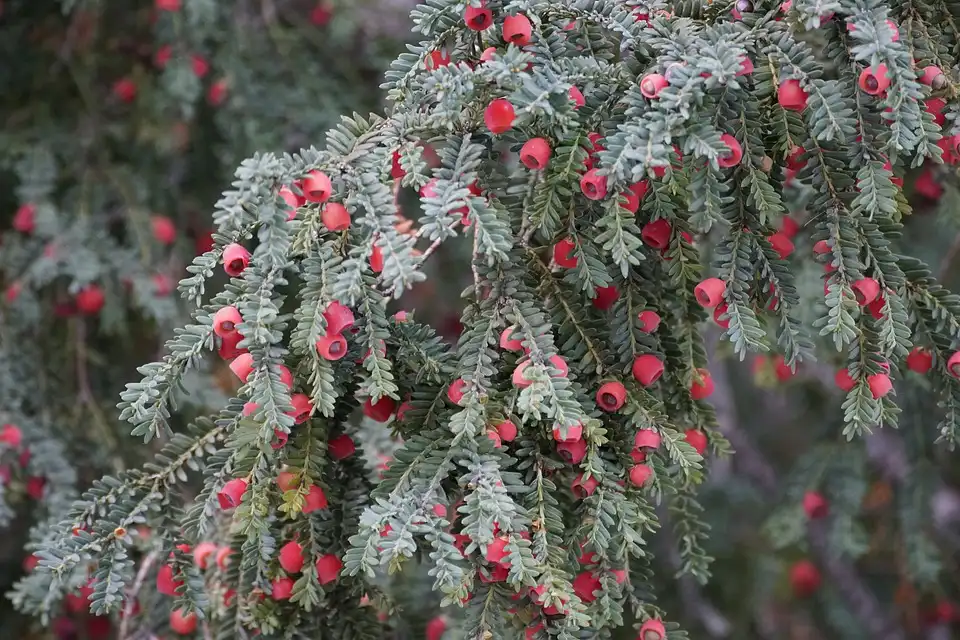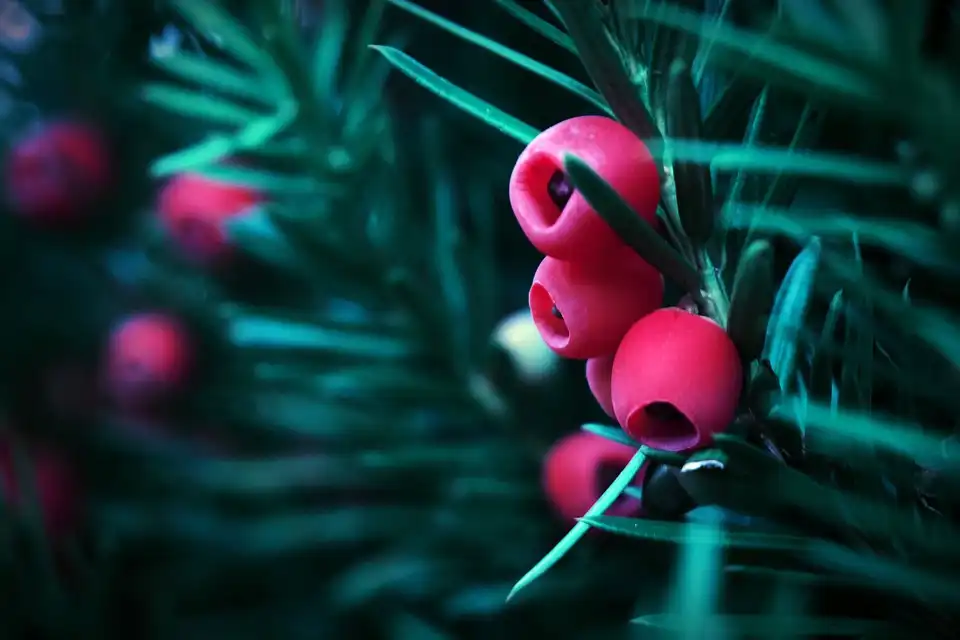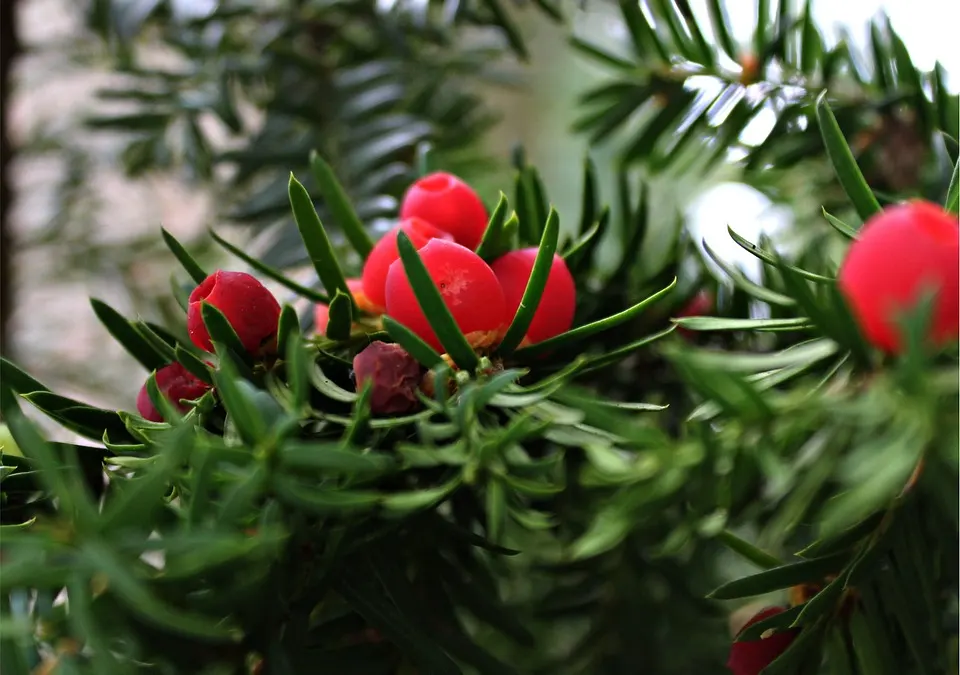The Mystical Yew: A Tree of Life and Death
The natural world is full of wonders that find themselves at the center of human spirituality. Wherever you go, you’ll find rock formations worshipped by ancient races, trees revered by indigenous peoples, and stone megaliths driven deep into the ground for various spiritual and early scientific purposes. But nowhere will you find a natural feature more widely revered, symbolic, and important to the human race than the awe-inspiring yew tree.
From the United Kingdom and the ancient Celts to the Mediterranean and the Holy Roman Empire, all the way to the worldwide phenomenon that is modern Christianity, the yew has somehow rooted itself as potentially the most significant tree the world has ever known. The first thing that sets this magnificent tree apart from all others is that in the eyes of a single culture, it represents both life and death.
Our Complex Relationship with Death
Death in modern terms is vastly different from how many ancient peoples saw it. Today, we see finality, the ultimate end of life. We regard death primarily with fear. Not everyone has a fear of dying, but we fear other aspects of the experience. We fear leaving our loved ones behind; further to that, we fear leaving them piles of paperwork to sort out and arrangements to make. We fear dying too young and not having the opportunity to accomplish what we feel we’re on this earth to do.
We fear dying without saying a final goodbye to our loved ones, and we shudder to think that we might die while on bad terms with some of our most cherished familiars. Some people fear that death will be painful. Most people have a far more debilitating fear, one that shakes us to our core and gives us night terrors; Where will we go?
This question is one that religions and faiths have tried to answer throughout human history. Most cultures believed in an afterlife; most still do. But primarily, the afterlife was not a reward and punishment-based system; it was merely another part of the human experience. Death was seen as a transition, not one to be feared or saddened by, but one to be celebrated.
There is much metaphorical symbolism attached to the concept of death. It doesn’t always mean the rapid physical decay of the human vessel; sometimes, it’s the death of the ego and the birth of enlightenment. Enlightenment is largely viewed as a death because it means losing everything you valued most about yourself and your experience. Enlightenment forces you to question the very nature of existence in ways most wouldn’t be able to comprehend.
Many psychotherapists explain the death of the ego as deeply traumatic because the ego is largely what defines most of us as humans. Losing that connection brings about a change within our deepest core and realizations that the ego doesn’t allow to occur.
Everyone experiences enlightenment slightly differently, but the basic concept is that you realize that nothing is separate and nothing holds any more importance over anything else in the universe, including yourself. Enlightenment is explained as a water droplet falling into an ocean. Once the drop falls into the ocean, it is no longer a water droplet; it is the ocean. In the same way, enlightenment encourages the realization that you are not a being who possesses life, but you are life itself. This is a belief that many ancient races held and one that the yew is very much associated with as the tree of enlightenment.
With the concept of death, rebirth must follow. Some cultures believe you can die a thousand times in one lifetime, but each time you will be reborn. The ancient Celts were one such people. They also saw death as a mystical gateway between the realms of now and hereafter, and they believed that gateway to be the magnificent yew.
The Tree of Death
The Celts of what is now Great Britain are possibly the culture most associated with the yew tree. Here, in the ancestral home of Wicca and other such modern magical movements, the yew tree was simultaneously symbolic of many concepts and conditions of the human experience. In some places where the old paths are still followed to this day, the yew still has such immense importance. It is seen as a deeply spiritual and mystical tree, with some more dedicated practitioners of the magical arts even considering them living immortal beings, not just trees.
The yew is so engrained in Celtic history that the two are almost inseparable. Some Scottish poets have even called it ‘the tree of resilience.’ The weeping yew, especially, became the subject of Druidic fascination due to the peculiar growth habits it exhibits. As the tree grew, ancient druids observed that its long, low branches, rather than grazing the ground like many aged weeping trees do firmly embedded themselves in the soil. As a result, a new tree grew green and strong from the old branches, which began a whole new life cycle for the majestic yew. Thus, among the Druidic classes, yew trees were known as trees of life and trees of longevity.
Perpetually Toxic
The yew was also known to Celts as the tree of death. Celts used fluids from the spiny foliage and berries of the yew tree to dip their arrows in before hunting since they were familiar with its toxicity. Taxine, a toxic alkaloid found in the yew tree, is known to be one of the most toxic chemicals in the world, with all components of the tree – except for the fleshy red part of the berry – containing lethal amounts of the poison. The yew tree’s taxonomical name, Taxus baccata, alludes to this. This lethal toxicity is not limited to the yew common to the United Kingdom; it is also found in copious amounts in the Japanese yew, Taxus cuspidata.
The toxicity of the yew is sometimes disputed or doubted, particularly by people keen on using them for aquascaping. For this reason, many experiments have been done to determine the concentration of taxine in various parts of the tree. The experiments reveal that taxine A and B were present in virtually the same amounts in roots, branches, and seeds of newly harvested samples and samples that had been allowed to age once harvested. The yew tree is widely associated with being immortal, but so is its toxicity.
The core issue with taxine is that it is insoluble in water. So while the pieces of the tree you’ve taken for your aquascape will decay over time, taxine will not. Instead, it could poison your fish stock and, in the right concentrations, could even be lethal to you. When handling any kind of poisonous substance, the right precautions need to be taken.
The Guardian of the Dead
The yew in Celtic mysticism was also heavily associated with the goddess Hecate. Hecate is known as the Queen of the witches and is still a prominent deity in most practices of magic. She is also associated with the night, the moon necromancy, and spirits. Her name means ‘worker from afar’ and was taken from the Greek word Hekatos. Another prominent connection with Hecate is death, more particularly, the spiritual transition that death represented to ancient cultures like the Celts.
Hecate was seen in some circles as the custodian of death. She was a guardian of the souls on their journey to the other world, and she was revered as such. The Celts saw the mystical yews as Hecate’s sentinels. The dead were buried beneath them and were guarded by them in service to Hecate. Several legends suggest that yews grew more ferociously when able to extract nutrients from human remains. This is not a foreign concept as we use bone meal on many plants to promote better, faster, and stronger growth.
But this association with Hecate and death also made yews the subject of certain fears. Some Celtic mothers cautioned their children to stay away from yews as they were believed to provide shelter to witches. While magic was very much a part of pagan and Celtic existence, there was, and is still an important distinction between nature-based belief systems and systems that claim to leverage darker powers.
Back to the yew, the tree was deliberately planted in cemeteries throughout the Celtic and subsequent early British world for a rather peculiar reason. Corpses are thought to be held in place by the tree. According to legend, the yews protect bodies by growing new roots into their mouths. As a result, the yew becomes directly associated with the body of a deceased person, becoming an important element of the natural ecosystem. In addition, it echoes the first words of the emerald tablet, As above, so below. I found this to be an incredibly striking parallel. Our relationship with each other in life is just as important as our relationship with nature in death.
The Tree of Life
The Sacred Tree has two primary forms: the tree of knowledge, which connects the different realms of existence, and the tree of life, which connects all forms of creation with its vast branches and roots. These two trees are portrayed in various religions and philosophical schools of thought as the same organism.
The Ancient Assyrians
The tree of life iconography goes all the way back to the Assyrians of ancient Mesopotamia. In Assyrian art, numerous nodes and crisscrossed lines represented the tree of life. Evidently, it was a prominent spiritual and religious symbol, frequently tended to by human or winged genies or the King, and even blessed or fertilized by buckets and cones in Assyrian palace reliefs. While a physical tree didn’t represent the tree of life in Assyrian culture, it still carried the same attributes of immortality as later depictions from other cultures.
Arcane Chinese Mythology
An image of a tree of life often depicts a phoenix and a dragon; the dragon is often a symbol of immortality in Chinese mythology. In Taoist mythology, a peach tree produces an immortal fruit every three thousand years, and anyone who eats it becomes immortal.
A sacrificial pit was discovered in Sichuan, China, in the 1900s. It contained three bronze trees, which were 4 meters high and dates to about 1200 BCE. It had a dragon at its base, and fruit hung from its lower branches. An unusual bird-like creature resembling a phoenix rested on top of the tree. The dragon and phoenix are representative of Yin and Yang energy, and as covered in a previous article, they are both powerful symbols in Feng Shui. The dragon carries the energy of the divine Emperor, and the phoenix the energy of his equal but opposite Empress.
Sichuan is also home to a tree of life dating back to the late Han dynasty. A horned creature with wings guards the ceramic base of this particular specimen. The horned creature is theorized to be a dragon, or possibly a sacred combination of the dragon and phoenix, embodying both of their powerful energies. There are coins and people on the tree. At the apex of the sacred tree at Sichuan is a bird-like creature carrying the sun.
China is an important place to mention when discussing the tree of life because it is the birthplace of the patient art of Bonsai. Called Penjing or Penzai back then, Bonsai originated in China and was practiced exclusively by the highest echelons of society. Japan adopted the noble art form and made it available to anyone to practice. The yew is a popular choice for bonsai enthusiasts because of its peculiar growth patterns, the symbolism of immortality, and its beautiful features.
Due to its ability to bend, endure, and survive, the evergreen Pine Tree is known as the Tree of Life in Taoism. Taoists believe that nature is an intricate balance between Yin and Yang and that any attempt to favor one extreme over the other will be self-defeating, ineffective, and ultimately short-lived. Although complementary, Yin and Yang are in opposition with each other, with perfect peace, understanding, and balance with the universe resting between them.
Trees are excellent examples of Yin and Yang in that they exhibit both receptivity, which is feminine energy, and expansiveness, which is masculine energy. They also represent two other opposing concepts; survival in the way their roots spread to find nutrients and proliferation in the way that they flower or produce fruits. The yew is the ultimate representation of these concepts because it is relentless in its survival by growing its roots deep and strong and equally persistent in the proliferation of its very being by rooting its branches into the ground to become the trunks of new trees.
Supreme Unity Wu-Ji is limitless and produces the delimited Ta-Ji according to the Taoist creation myth. Ta-Ji is divided into heaven (Yang) and earth (Yin). Heaven and earth are united by the human form, experiencing supreme unity. One cannot exist without the other. This ties in with the experience of enlightenment, and there is a beautiful verse by Chuang Tzu, an early Taoist philosopher, that speaks to this point:
“Birth is not a beginning; death is not an end. There is existence without limitation; there is continuity without a starting point. Existence without limitation is Space. Continuity without a starting point is time. There is birth; there is death, there is issuing forth, there is entering in.”
Norse Mythology
Norse religion references the tree of life as Yggdrasil, the world tree, a massive tree surrounded by extensive lore. This Norse tree of life is believed to be either the ash tree or the magnificent yew. Even in the furthest reaches of Nordic European antiquity, the yew is revered as the tree of life, a biological being connecting the humans to their gods, higher-selves, and higher planes of existence; in other words, enlightenment.
Germanic tribes have been documented as honoring sacred trees within their societies, perhaps related to Yggdrasil. The Sacred tree at Uppsala, Thor’s Oak, and the wooden Irminsul pillar are examples of these highly honored trees. The apples from the Iðunn’s ash box are the source of the gods’ immortality in Norse mythology. This strong association with trees and immortality and enlightenment still plays a vital role in movements and schools of thought like Germanic Neopaganism.
Christianity
Genesis 2:9 and 3:22-24 describe the tree of life as the source of eternal life in Eden, from which man is expelled when he commits original sin. This tree is also known as the tree of the knowledge of good and evil. In its simplest form, this phrase speaks of an eerily similar tree to other much older faiths and traditions; the tree of knowledge or the tree of enlightenment.
There is another appearance of the tree in the last book of the Bible, the Book of Revelation, especially in the last chapter as part of the new garden of paradise. The King James Version states that those who wash their robes or comply with the Lord’s commandments have the right to the tree of life. A similar statement can be found in Rev 2:7, where the tree of life is portrayed as a reward for those who endure. According to Revelation 22, God’s throne is the source of a pure river of water of life. It appears that the river feeds two trees of life, one on either side of the river, and both bear twelve kinds of fruits. The leaves of the trees are said to heal the nations.
During his pontificate, Pope Benedict XVI proclaimed that the cross is the true tree of life. Saint Bonaventure taught that Christ is the medicinal fruit of the Tree of Life, and Saint Albert the Great taught that the tree of life was actually the Eucharist, the body and blood of Christ.
But what does the tree of life in Christian terms have to do with the yew? The earliest forms of Christianity incorporated elements of other religions’ sacred rites, rituals, and beliefs. This was likely done to make the faith easier for other tribes to accept or another reason entirely. In this way, the importance and sacred symbolic nature of the yew tree were preserved and rooted as deep within the new faith as it was in the faiths and traditions of the ancient world.
In the same way that the branches of the pervasively majestic yew grew and spread, so did the new religion’s influence.
A rite that originated around the yew tree is Palm Sunday. This key Christian celebration was originally celebrated with the yew tree’s branches. Palm Sunday is the Sunday before Easter and is observed by Christians worldwide. Jesus Christ of Nazareth arrived in Jerusalem, the Holy Land, on this day in the Judeo-Christian faith. Palm fronds were traditionally placed on the path Jesus was to walk, as suggested by the name. As a result of the diminishing supply of palm trees in unsuitable climates, these were often replaced by native trees such as olive, box, willow, and the sacred yew.
There is a possibility that the substitution was entirely coincidental. Even so, other uses of the yew in Christendom illustrate a faith whose leaders understood the tree’s historical significance to followers of more arcane paths. Even stranger, controversial documents and ancient texts might hint that the yew had far greater importance to Christianity than the official texts suggest. In these texts, it is suggested that the tree represented more than just a substitute in many rites and rituals; it was the tree of the knowledge of good and evil, the burning bush, gave the wood that the cross of Jesus was carved out of, and was the tree that grew from the bones of the first man, Adam.
A Medical Miracle
Taxol, a chemical compound found in the bark of Pacific yew trees (Taxus brevifolia), is effective for treating cancers of the breast, lung, ovary, and testis. Additionally, it was found in the foliage and wood, but the bark contained the highest concentration. About half of the amount was found in the foliage, and the wood was considerably less.
Trees do not create taxol on their own but rather via some symbiotic process with a microorganism. Presently, taxol is produced by culturing for medical purposes. Taxol, which can be obtained only by hot alcohol extraction, is extremely toxic in small doses (hence its effectiveness as an anti-tumor med). Other extractives may be present due to this symbiotic process too, but taxol is by far the most prominent.
Final Word
This one age-old tree has rooted itself in the mythologies, beliefs, rites, rituals, and celebrations of so many of the world’s religions and belief systems. Its raw magical and mystical energy has endured time and the transition of power from one deity to the next and has inspired many poets, historians, and blog post writers. It seems that no matter which path you follow, the yew is a sacred tree. Not to exclusively the Celts, or the Chinese, or even the Christians, but to humanity as a single unified and vastly accomplished race.







